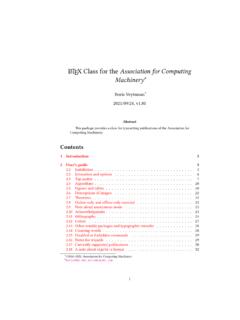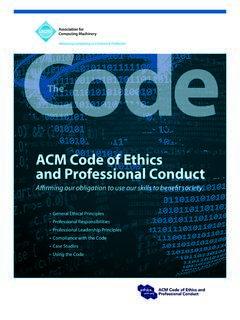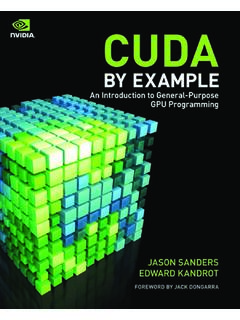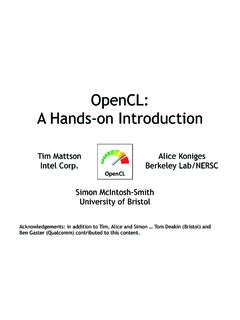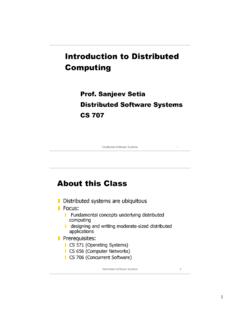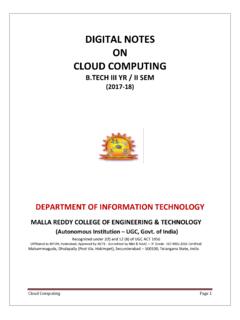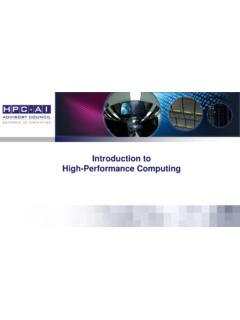Transcription of ACM Computing Classification System (CCS)
1 Page 1 of 5 HOW TO CLASSIFY WORKS USING ACM S Computing Classification System An important aspect of preparing your paper for publication by ACM Press is to provide the proper indexing and retrieval information from the ACM Computing Classification System (CCS). This is beneficial to you because accurate categorization provides the reader with quick content reference, facilitating the search for related literature, as well as searches for your work in ACM s Digital Library and on other online resources. We need to have you apply the categories for your paper because you are the expert on the contents of your paper. We provide the following description and guidance, based on the 2012 CCS.
2 The 2012 CCS involves a six-level tree. Example: Categories: Software and its engineering Software organization and properties Contextual software domains Software infrastructure Middleware Message oriented middleware We suggest the following steps be used in preparing your classifications: 1. It is strongly recommended that you look through published issues of the journal or proceedings in which your paper is to appear in the ACM Digital Library to see how papers on the same or related topics have been classified. You can also locate a particular CCS 2012 concept in the interface and can click on the recent papers link (located in the left panel) to view recently published materials which were indexed with that term.
3 2. Before starting the Classification process, take a few minutes to familiarize yourself with the 2012 Classification tree. 3. Use any first- and second-level nodes of the Classification scheme which are relevant to your paper, then look at the lower levels under them. Identify the lowest branches of the tree that seem to apply to your particular paper. The more specific the concept the better. For example, for the paper "An efficient method for checking object-oriented database schema correctness," by A. Formica et al., appearing in the September 1998 issue of ACM Transactions on Database Systems, the categories would include: Page 2 of 5 (1) Information systems---Database management System engines (2) Software and its engineering---Software notations and tools---General programming languages---Language features---Inheritance (3) Software and its engineering---Software notations and tools---General programming languages---Language features---Classes and objects (4) Information systems---Data management systems---Database design and models---Graph-based database models (5)
4 Information systems---Data management systems---Database design and models---Data model extensions Use the lowest node in the tree available and preferably use the leaves of the tree when applicable. Use as many concepts under a single node as are appropriate for the paper unless they all apply or none of them apply in those cases just use the single more encompassing node itself. For example, use Information systems---Data management systems if the paper deals with the general concepts of Data management systems. 4. You will also need to assign weights to each Classification term you are using. ACM uses a 3 level weighting System : High, Medium, and Low.
5 NOTE: If you are using LaTeX templates, the relevancies will be translated to scores for processing in your file: High relevance indicated by a score of 500 Medium relevance indicated by a score of 300 Low relevance indicated by a score of 100 For example, Information systems---Database management System engines;500 indicates that the Classification term chosen for this work has high relevance to the subject matter of the publication. Providing proper weights to Classification terms improves relevancy ranking in ACM Digital Library search result sets. 5. Further, granular terms not included in the 2012 CCS need to be listed within your Author Supplied Keyword section of your article.
6 Please consult the Word or LaTeX template documentation for formatting of this section. Page 3 of 5 6. Use higher level nodes only if the article covers most of the concepts under it or if the article cannot be classified under any other node. This would usually apply only to broad survey papers, for example: "Performance and dependability evaluation of scalable massively parallel computer systems with conjoint simulation," by A. Hein and M. Dal Cin, appearing in the October 1998 issue of ACM Transactions on Modeling and Computer Simulation: Networks---Network performance evaluation;300, Computer systems organization---Dependable and fault-tolerant systems and networks;300, Computing methodologies---Modeling and simulation--- Simulation types and techniques---Massively parallel and high-performance simulations;500, Software Engineering---Software organization and properties---Software System structures---Software System models;300, and General and reference---Cross- Computing tools and techniques---Performance;100.
7 7. Beware of a common pitfall---namely, the use of an inappropriate section of the tree. For example, do not use the descriptor "Public Internet" under Networks---Network types, unless you are really dealing with Networks. If the paper discusses the Internet in terms of governance, then the proper Classification would be Social and professional topics--- Computing / technology policy---Intellectual property---Internet governance / domain names. 8. Use of nodes within Cross- Computing tools and techniques should be used independent of the other nodes in the tree. For example, for the paper in Step 5, Performance was chosen as an additional relevant term.
8 9. After you have made the decision about all applicable nodes, use the ACM CCS tool ( ) to prepare your CCS terms in the format: a. Drill down to the appropriate node level and click on Assign This CCS Concept , then choose the appropriate relevance ( High , Medium , or Low ) b. You may find it necessary to provide multiple terms at the same relevancy level. c. It is not uncommon to include 6 or more terms for an article; repeat these steps for other assigned nodes using the continue link. d. You can reset the captured nodes at any point using the reset link e. Once you have completed classifying your paper, you are ready to insert the codes into your document.
9 If you are using Word templates follow the instructions in point 1; LaTeX template users, please use the instructions within point 2. 1. a. For insertion into the ACM article Word template, copy and paste the formatted text from the CCS tool using the view CCS display link into the Categories and Subject Descriptors section: Information systems~Database management System engines Computing methodologies~Massively parallel and high-performance simulations Networks~Network performance evaluation Computer systems organization~Dependable and fault-tolerant systems and networks Software and its engineering~Software System models Software and its engineering~Inheritance General and reference~Performance Page 4 of 5 b.
10 An additional step is necessary to ensure that the proper CCS terms are added to the Digital Library citation page: 1. From the view CCS TeX Code listing, click on Show the XML Only 2. Highlight and copy the XML code from the window If you are using Microsoft Word 2010 or higher you must insert the XML code into your word document s properties: 3. If you are using Microsoft Word 2010 or higher you must insert the XML code into your word document s properties: a. From your word document, click on File , then the Info tab on the left side panel, then click Properties and select Show Document Panel. b. Click within the Tags metadata field and paste the XML data.
